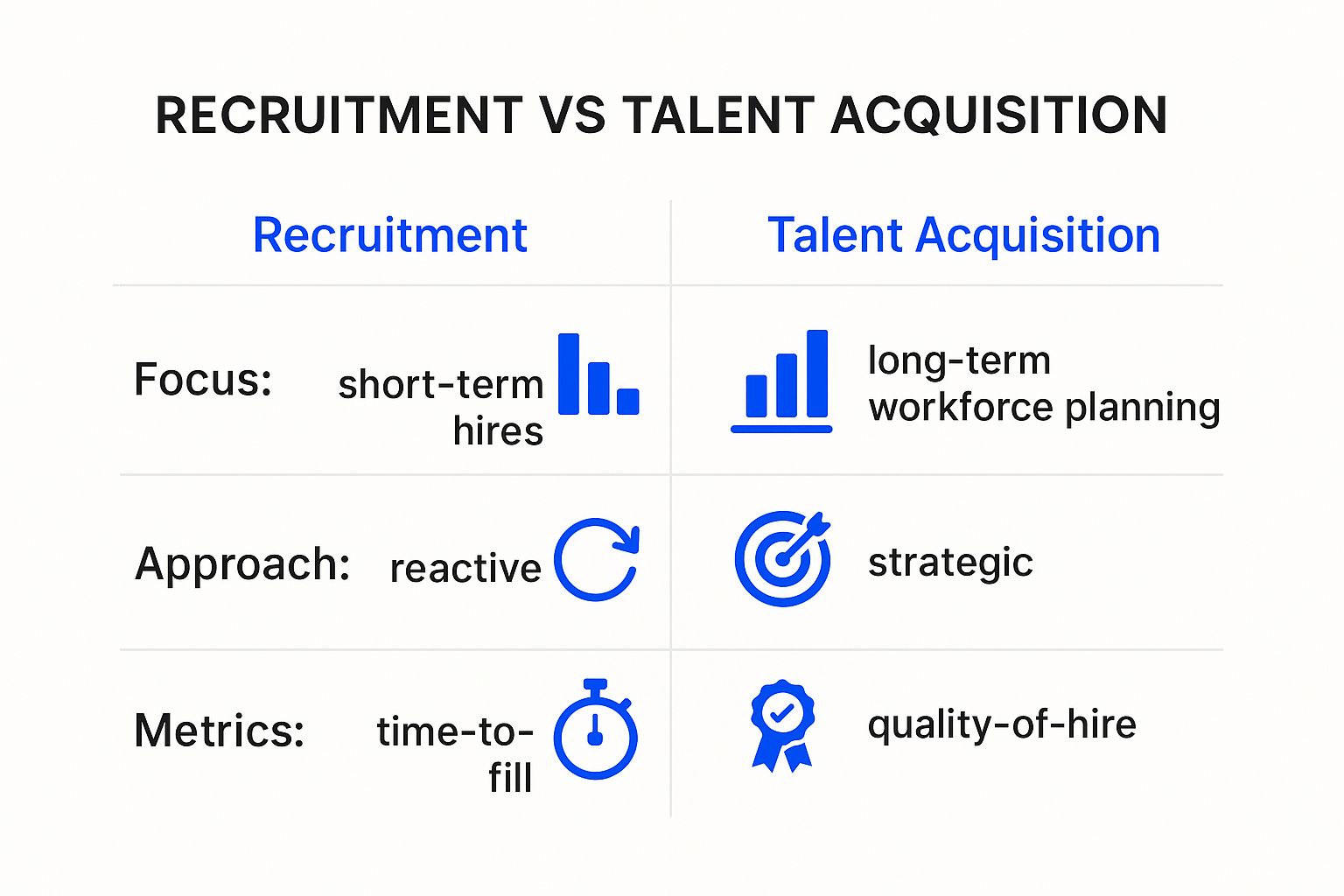Talent acquisition isn't just a fancy term for hiring. It's the long-game strategy of finding, attracting, and bringing on board the right people to drive your company's future success. Think of it less like plugging a leak and more like designing a robust plumbing system for the entire house. It’s about building a team that will win championships for years to come, not just filling a spot on the roster for the next match.
What Is Talent Acquisition Really About?
To get to the heart of talent acquisition, it helps to see how it differs from traditional recruiting. Most people use the terms interchangeably, but they represent two very different mindsets.
Recruiting is tactical. It’s a direct response to an immediate need: filling an open vacancy as quickly and efficiently as possible. The process kicks off when a role opens up and finishes once a contract is signed. It's reactive by nature.
Talent acquisition, on the other hand, is a strategic, ongoing cycle. It’s about looking at the big picture and asking, "What kind of talent and skills will we need in one, three, or even five years to stay ahead?" This means building relationships, nurturing talent pipelines, and strengthening your employer brand long before a specific job description is even written.
A recruiter is like a firefighter, expertly putting out the immediate fire of an empty role. A talent acquisition specialist is the architect, designing a fire-resistant building from the ground up to prevent future emergencies.
A Proactive Approach to Building Teams
This forward-thinking approach is no longer a luxury; it's a necessity. The UK's talent market is grappling with a significant skills shortage, with an estimated deficit of 2.5 million highly-skilled workers. This gap is costing UK businesses a staggering £6.6 billion each year in lost revenue and productivity, highlighting why a proactive strategy is crucial. You can explore these numbers in more detail in this report on UK recruitment statistics.
To break it down even further, let's look at the core differences side-by-side.
Talent Acquisition vs Recruiting at a Glance
This table clearly lays out how the strategic, long-term focus of talent acquisition compares to the tactical, short-term nature of recruiting.
While both functions are essential for a healthy organisation, they serve distinct purposes. Recruiting gets someone in the door now; talent acquisition ensures the right people are always ready to walk through it.
This infographic captures the fundamental shift in perspective.

As you can see, the real difference is in the mindset. Talent acquisition is all about the strategic impact a new person brings to the organisation, not just the speed of filling a seat. It's this move from a reactive to a proactive model that lies at the heart of what we do. It’s not just about hiring; it’s about building a sustainable, high-calibre workforce that fuels lasting business growth.
The Pillars of a Modern Talent Acquisition Strategy

A powerful talent acquisition strategy isn’t a single action; it’s a framework built on several interconnected pillars. When these elements work together, you create a system that doesn’t just fill empty seats but attracts and keeps the high-performers who will define your company’s future. Think of it like building a house – each pillar is essential for stability and long-term strength.
This entire structure rests on a foundation of smart workforce planning. It means looking beyond today's immediate vacancies to forecast the skills and roles your business will need in the next one to three years. It’s about getting ahead of the curve, anticipating growth, mapping out talent gaps, and aligning every hire with your company's big-picture goals.
Building an Authentic Employer Brand
Your employer brand is essentially your reputation. It's how job seekers and your own team see your company as a place to work. This is the story you tell about your culture, values, and mission, shared across channels like LinkedIn, Glassdoor, and your own careers page. A genuine brand acts like a magnet, pulling in professionals who want more than just a pay cheque.
The key word here is authentic. A strong employer brand has to reflect the real, day-to-day experience of working at your company. When what you say on the outside matches the reality on the inside, you build trust and attract candidates who are a natural cultural fit. This, in turn, does wonders for your retention rates. To boost their leaders' presence and amplify this brand message, some companies are even leveraging LinkedIn ghostwriters to shape their public narrative.
Your employer brand is what people say about you as an employer when you're not in the room. A great strategy ensures they’re saying the right things.
Diversifying Your Sourcing Channels
Just posting on job boards is like fishing in a single, overcrowded pond. A modern talent strategy casts a much wider net, finding top talent wherever they are—not just where they happen to be looking for a job. This proactive mindset is crucial for building a rich and varied pipeline of candidates.
Effective sourcing means using multiple channels at once. Here are some of the most effective:
- Employee Referral Programmes: Year after year, these prove to be one of the best sources for quality hires. Your current employees know your culture inside and out and can spot people in their networks who would genuinely thrive.
- Professional Networks: Getting involved in industry communities on platforms like LinkedIn or attending events (both virtual and in-person) can connect you with passive candidates—those talented folks who aren't job hunting but are open to a great opportunity.
- Direct Sourcing: This is all about proactively identifying your ideal candidates and reaching out to them directly. For a closer look at how to do this well, our guide on talent sourcing strategies offers a deep dive into building these crucial connections.
By weaving together these pillars—strategic planning, authentic branding, and diversified sourcing—you create a talent acquisition process that's both comprehensive and resilient. This approach ensures you're not just reacting to hiring needs but are actively and intentionally building the exceptional team that will drive your business forward.
Navigating the Current UK Talent Landscape
The ground is shifting for UK businesses. If you’re still taking a reactive approach to hiring, you’ll struggle to build a resilient team. With widespread economic uncertainty, many organisations are naturally becoming more cautious, and that has fundamentally changed what it takes to attract top performers.
This caution is rippling through the job market. We're seeing major fluctuations in talent acquisition across the UK, driven by these broader economic pressures. The recruitment sector, for example, has seen a sharp contraction in permanent placements. Businesses are simply hesitating to make long-term financial commitments in such an unpredictable climate. You can get a deeper look into how these trends are reshaping the UK recruitment sector and what it means for the future.
But a downturn in permanent hiring doesn't mean the demand for skilled professionals has simply vanished. Far from it. It's just created a different kind of opportunity.
The Rise of Flexible and Fractional Work
To navigate this volatility, UK companies are putting a premium on one thing: flexibility. This has led to a noticeable resurgence in temporary and fractional roles, which are now a significant slice of the market. Businesses are bringing in interim support to fill critical skills gaps without the long-term overhead of a permanent hire.
This move towards more fluid working arrangements creates a huge advantage for organisations that know how to adapt. It means there’s a growing pool of highly skilled professionals—people with deep experience who can deliver immediate value—available for project-based, part-time, or fractional work.
For agile businesses, this market isn't a challenge—it's an opportunity. The rise of temporary and fractional talent allows you to access specialised skills precisely when you need them, building a more adaptable and cost-effective workforce.
What This Means for Your Hiring Strategy
The current landscape demands a strategic pivot. If you're only relying on traditional models to hire permanent, full-time staff, you're likely missing out on some of the best people available. A modern talent acquisition strategy has to incorporate these flexible models to stay competitive.
Here’s how you can start adapting your approach:
- Embrace Agility: Your hiring framework needs to be flexible enough to handle different types of employment, from permanent roles to short-term contracts and fractional experts.
- Widen Your Talent Pool: Start actively sourcing interim professionals and consultants. These individuals can fill immediate needs and provide high-level skills without the long-term costs.
- Focus on Value, Not Just Headcount: Shift your mindset. Instead of thinking only in terms of filling a seat, focus on the specific skills and value a professional brings to the table, whatever their contract type.
By understanding and adapting to these UK market dynamics, you can turn economic caution into a genuine competitive advantage. This flexible approach lets you build a more resilient, skilled, and responsive team that's ready for whatever comes next.
How Technology is Reshaping Talent Acquisition

In today's fiercely competitive hiring market, technology isn't just an add-on; it’s the very foundation of a successful talent acquisition strategy. The days of sifting through mountains of paper CVs are long gone. Modern tools are now essential for handling the complexity and volume of attracting the best people.
Think of an Applicant Tracking System (ATS) as the central nervous system for your hiring operations. It's more than just a digital filing cabinet; it organises every application, tracks each candidate's journey, and automates routine communications. This frees up your team to focus on the human side of hiring, rather than getting bogged down in repetitive admin.
Alleviating Pressure with Smart Tools
Talent acquisition teams across the UK are feeling the squeeze. As new technologies emerge, many recruitment professionals find their workloads have become unmanageable. This pressure is compounded by intense competition for skilled talent, which a huge number of TA leaders cite as their biggest challenge. If you're interested in the numbers behind this, you can discover more recruiting statistics here.
This is exactly where the right technology can be a game-changer. By taking on the administrative heavy lifting, it gives teams the breathing room they need to do what they do best: build meaningful relationships with candidates.
Technology’s greatest contribution to talent acquisition is not replacing the human element, but rather creating the time and space for it to flourish.
The Rise of AI and Data-Driven Hiring
The impact of technology goes far beyond basic automation. Artificial intelligence and data analytics are making the entire talent acquisition process smarter, not just faster.
AI-powered platforms can do much more than simply organise CVs.
Intelligent Sourcing: These tools can search millions of online profiles to find brilliant passive candidates who fit your criteria perfectly, even if they aren't actively looking for a new role.
Bias Reduction: Some platforms can hide personal details like names or backgrounds during the initial screening. This helps to reduce unconscious bias and level the playing field, leading to fairer hiring decisions.
Predictive Analytics: By looking at past hiring trends, technology can help you anticipate future talent gaps, pinpoint the most effective places to find candidates, and even forecast who is most likely to thrive in a specific role.
By embracing these tools, companies can move from a reactive "post and pray" approach to a proactive, strategic one. This data-informed model leads to smarter decisions, a better experience for candidates, and ultimately, a much higher quality of hire. It turns talent acquisition from a simple operational task into a cornerstone of business success.
Measuring What Matters in Talent Acquisition

You can't improve what you don't measure. In talent acquisition, relying on gut feelings is a recipe for wasted time and money. A truly effective strategy is built on solid data, allowing you to see what’s working, what isn’t, and where you can make real improvements.
Shifting from guesswork to data-driven decisions is what separates an average hiring function from a great one. To do this, you need to track key performance indicators (KPIs) that paint a clear picture of your process and its impact on the business.
Essential Talent Acquisition KPIs
While you could track dozens of data points, a few core metrics tell you almost everything you need to know about the health of your hiring efforts. These KPIs help you understand efficiency, cost, and most critically, the long-term value your new hires bring to the organisation.
The table below breaks down the essential KPIs every modern talent team should be tracking. These metrics provide a clear, objective view of your entire process, helping you make smarter, data-informed decisions.
These KPIs are interconnected; focusing on one at the expense of others can lead to poor outcomes. The real goal is to find a healthy balance that delivers sustainable results.
The True North Star: Quality of Hire
It's easy to get fixated on hiring quickly and cheaply. But a low Cost per Hire that results in a poor-quality employee isn't a victory—it's an expensive mistake that often leads to low morale, poor performance, and eventually, another costly recruitment cycle.
A low Cost per Hire with a poor Quality of Hire is not a win—it's a costly mistake waiting to happen. True success is found in bringing on board high-calibre individuals who drive the business forward.
This is why Quality of Hire is arguably the most important metric of all. It proves your strategy is finding people who don't just fill a seat but actively contribute to the company's long-term success. You can measure it by looking at performance review scores after 90 or 180 days, checking manager satisfaction surveys, and tracking retention rates.
Strong retention, in particular, is a powerful sign of a great hire. If you're keen to keep your best talent on board, it's worth learning how to improve employee retention.
Assessing a candidate's potential also goes beyond their CV. To find the right fit, especially for leadership roles, understanding personality is vital. Tools like a Personality Test for Business Leaders can offer deeper insights into a candidate's working style and how they'll align with your culture. When you prioritise and accurately measure Quality of Hire, you’re not just filling roles; you’re building a stronger, more resilient workforce.
Gaining a Competitive Edge with Remote Hiring
If you’re still limiting your hiring to a specific postcode, you're playing on a much smaller field than your competitors. Embracing a remote or hybrid hiring model is one of the most powerful moves you can make to modernise your talent acquisition strategy. It’s about more than just flexibility; it's a direct solution to the persistent skills shortages felt across the UK.
When you remove geographical barriers, your talent pool doesn’t just get bigger—it becomes global. Suddenly, you have access to exceptional professionals you’d never find otherwise. This isn't just about getting more applicants; it's about finding the right person without having to compromise on skills or experience. A well-oiled remote hiring process cuts through international recruitment complexities, handles compliance, and slashes the overheads tied to a traditional office.
Unlocking Global Talent Pools
Hiring remotely allows you to tap into rich talent markets that your competitors are likely ignoring. It lets you focus purely on what matters: skills, experience, and cultural fit, instead of a candidate’s commuting distance. For a closer look at the practical side of this, particularly for technical roles, check out this guide on how to hire remote developers like a pro.
Bringing in people from different backgrounds and locations injects fresh perspectives and new skills into your organisation. This naturally fosters innovation and makes your entire team stronger. It fundamentally changes hiring from a local search into a worldwide talent hunt.
The real advantage of remote hiring is not just cost savings; it's the freedom to build a world-class team without geographical limitations. It’s about hiring the best person for the job, wherever they may be.
Adopting this model means you can fill your most critical roles faster and with better-suited people. The trick is to have a structured process that makes the experience seamless for everyone involved, from hiring managers to the candidates themselves. For a detailed roadmap on building that structure, have a look at our guide to effective remote hiring strategies. At the end of the day, this modern approach is how you secure the talent needed to drive genuine, long-term success.
Frequently Asked Questions About Talent Acquisition
Even with a solid strategy in place, you're bound to run into some practical questions when you start putting talent acquisition into action. Let's tackle a few of the most common ones we hear from business leaders and HR pros.
How Is Talent Acquisition Different From HR?
It’s easy to see why these two get mixed up, but think of it this way: Human Resources (HR) is the whole universe of employee management. It covers everything from the moment someone joins to the day they leave—payroll, benefits, performance reviews, company policies, you name it.
Talent acquisition is a specialised discipline that lives within that universe. Its mission is singular and strategic: to find, attract, evaluate, and hire the right people to drive the company’s long-term goals.
So, while the TA team and the wider HR department are close partners, HR focuses on the entire employee journey. Talent acquisition is the crack team that gets the right people on the bus in the first place.
Can a Small Business Implement Talent Acquisition?
Yes, absolutely. Talent acquisition isn't about having a huge department; it's a strategic way of thinking. A small business might not have a dedicated TA team, but it can weave the principles of talent acquisition into its operations.
How?
- Plan for tomorrow's team: Don't just fill today's empty seat. Think about the skills you'll need six months or a year from now to hit your growth targets.
- Build your employer brand: Use your website, your social media, and every interaction to show people what it's really like to work with you. Showcase your culture and what makes you unique.
- Create a talent pipeline: Met someone amazing but don't have a role for them right now? Keep in touch. Nurturing those relationships means you have a pool of warm, interested candidates when the time is right.
Talent acquisition isn’t about the size of your budget; it’s about the quality of your strategy. Even small businesses can gain a significant advantage by thinking long-term about their people.
This forward-thinking mindset is what allows a small business to punch well above its weight and compete for fantastic people, even against bigger companies. It turns hiring from a reactive fire-drill into a proactive, strategic function that genuinely fuels growth, no matter how big your team is today.

